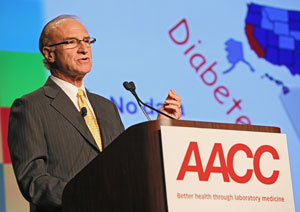
The 2013 Annual Meeting and Clinical Lab Expo opened with a fascinating lecture by C. Ronald Kahn, MD, on the complicated molecular pathology underlying the metabolic syndrome. Chief academic officer at the Joslin Diabetes Center in Boston and Mary K. Iacocca professor of medicine at Harvard Medical School, Kahn is internationally recognized for his pioneering research involving insulin signal transduction and the mechanisms of altered insulin signaling in disease. He was honored with the 2013 Wallace H. Coulter Lectureship Award, given annually at the AACC Annual Meeting to recognize individuals who have made lifetime commitments to laboratory medicine or patient care, and significantly advanced education, practice, or research.
Kahn made a compelling argument for unlocking the mysteries of the metabolic syndrome, owing to its link with obesity and type 2 diabetes, both of which are at epidemic levels, not only in the United States but also internationally. To the frustration of researchers, genomics has not proven to be particularly enlightening in understanding these conditions. Of more than 40 genetic loci associated with type 2 diabetes, only five polymorphisms cause a change in gene coding. "Most are in introns [non-coding] or intragenic regions and we don’t know if they have any function at all," he noted. Even more confounding, 85% of individuals carry the gene known to convey the largest risk for type 2 diabetes.
Insulin signaling and resistance pathways also are important in understanding the pathology of the metabolic syndrome, and like the genetics of this disorder, they are notably complex. "Once insulin binds to the cell, it creates a cascade of events, probably activating more than 100 different processes. One of our challenges in understanding insulin resistance is to understand which of these processes are resistant and which are not," Kahn explained. "Are different processes resistant to different cells of the body? Is the insulin resistance of obesity the same as the insulin resistance of type 2 diabetes? A lot of proteins and enzymes turn off the insulin signal, and we know very little about what regulates these turning off signals."
Evolving Evidence
Kahn went on to reflect how during his professional career the understanding about insulin action and insulin resistance has evolved considerably. Whereas decades ago, only three tissues—the liver, muscle, and fat—were thought to be insulin-resistant, research subsequently has demonstrated that insulin action takes place in virtually every tissue. "Even the pancreatic beta cell that makes insulin itself responds to insulin," he said. "So we have to put this complex pathway of insulin action on a complex whole body where every tissue can be responding to insulin in different ways and have different levels of insulin resistance."
By secreting hormones and releasing other actions that have both positive and negative signals, fat cells and adipose tissue-related macrophages also affect insulin action, Kahn explained. His investigation of these mechanisms in mouse models led to one of the most intriguing aspects of his presentation.
Kahn’s team found that obesity-prone mice have several distinct metabolic features, including higher expression of PKCδ, an enzyme involved in turning off insulin signaling. These mice also have more inflammation in their adipose tissue, and less brown and beige, energy-burning fat.
As they sought to better understand these differences, Kahn's lab found another potential factor: differences in the gut microbiome of the two substrains of mice. Experiments in normalizing the differences in the mice—including manipulating their gut flora—showed that the obesity-prone strain could become obesity-resistant. These findings, Kahn suggested, have opened a promising new avenue for understanding the metabolic syndrome and devising more effective ways to prevent and treat obesity, diabetes, and the metabolic syndrome.